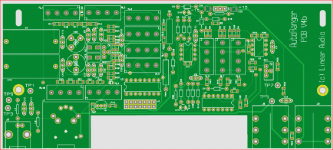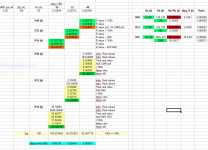you can also put me on the list for a couple of silent switchers, of which i have first hand experience.
It seems very useful to me, Jan... great job! 😎My friend Wisse was here last week and recorded a video with me waxing lyrically about the AR 🙂
My aim was to give a good run through what it is and what it does.
Feedback appreciated.
Autoranger video
Jan
Autoranger Update
OK, here's the situation at this moment. I have collected all your comments and suggestions, especially from Demain (thanks Demian) on the output levels.
I have just submitted what I hope will be my last prototype to Eurocircuits (see attached).
I have modified the switching logic so that now the maximum attenuation is -48dB. There will be two software-controlled settings for the nominal output levels to the soundcard input: 1V (0dBV) and -8dBV (which is around 400mV).
That means that with the maximum input level of 100VRMS, the output to the sound card will be either 1VRMS or 0.4VRMS. The software in the controller will be updated so the setting can be changed from the front panel, no need to open the box to change a jumper.
I also increased the input coupling to lower the LF -3dB frequency from 5Hz to below 2Hz.
The other thing, strictly software, will be some improvements to the Vout level display but that has no hardware implications.
I'll keep you updated, as usual. My plan is to start a Kickstarter before the summer, and offer a half-kit (all PCBs with SMD fitted, the box, the SilentSwitcher supply and programmed controller) where you only have to fit the through-hole components and put the assembly together. Of course I will supply a full detailed BoM.
I also plan to offer a complete, fully assembled and calibrated unit if it doesn't get too expensive 🙂
But keep your comments and suggestion coming nevertheless!
Jan
OK, here's the situation at this moment. I have collected all your comments and suggestions, especially from Demain (thanks Demian) on the output levels.
I have just submitted what I hope will be my last prototype to Eurocircuits (see attached).
I have modified the switching logic so that now the maximum attenuation is -48dB. There will be two software-controlled settings for the nominal output levels to the soundcard input: 1V (0dBV) and -8dBV (which is around 400mV).
That means that with the maximum input level of 100VRMS, the output to the sound card will be either 1VRMS or 0.4VRMS. The software in the controller will be updated so the setting can be changed from the front panel, no need to open the box to change a jumper.
I also increased the input coupling to lower the LF -3dB frequency from 5Hz to below 2Hz.
The other thing, strictly software, will be some improvements to the Vout level display but that has no hardware implications.
I'll keep you updated, as usual. My plan is to start a Kickstarter before the summer, and offer a half-kit (all PCBs with SMD fitted, the box, the SilentSwitcher supply and programmed controller) where you only have to fit the through-hole components and put the assembly together. Of course I will supply a full detailed BoM.
I also plan to offer a complete, fully assembled and calibrated unit if it doesn't get too expensive 🙂
But keep your comments and suggestion coming nevertheless!
Jan
Attachments
Last edited:
Hi Jan,
Your autoranger looks like a nice solution. But, why DIP for op-amps and not SOIC?
Btw, SOIC>DIP adapters looks so ugly...
Your autoranger looks like a nice solution. But, why DIP for op-amps and not SOIC?
Btw, SOIC>DIP adapters looks so ugly...
Hi Jan,
great progress!
Would it be possible to offer a bundle with just the bare pcb? I just learned how easy it is to solder smd parts.
Michael
great progress!
Would it be possible to offer a bundle with just the bare pcb? I just learned how easy it is to solder smd parts.
Michael
Hi Jan,
great progress!
Would it be possible to offer a bundle with just the bare pcb? I just learned how easy it is to solder smd parts.
Michael
I believe it would be much more expensive. There are a lot of unusual value 0.1% resistors which are relatively expensive in singles or duos. For say 100 pieces that is much different.
Jan
Hi Jan,
Your autoranger looks like a nice solution. But, why DIP for op-amps and not SOIC?
Btw, SOIC>DIP adapters looks so ugly...
Many DIYers still prefer DIPs where the device is available in DIP and space is not an issue. Working with SOIC is a pain for most DIYers, including myself. Jan is wise to include SMC for resistors, etc., as long as he provides them pre-mounted on the PCB.
Cheers,
Bob
Many DIYers still prefer DIPs where the device is available in DIP and space is not an issue. Working with SOIC is a pain for most DIYers, including myself. Jan is wise to include SMC for resistors, etc., as long as he provides them pre-mounted on the PCB.
Cheers,
Bob
Hi Bob,
I can understand your point. But, for ultimate performance I believe that we have to adopt SMD where SOIC is the least challenging dual op-amp form factor.
Btw, SMD op-amps can be pre-mounted too.
Regards/ Anders
Hey Jan, I was wondering when the Linear Audio Vol. 13 articles will be available for the individual download? Thanks.
Hi Bob,
I can understand your point. But, for ultimate performance I believe that we have to adopt SMD where SOIC is the least challenging dual op-amp form factor.
Btw, SMD op-amps can be pre-mounted too.
Regards/ Anders
However the OPA1622 may be a good choice and they are really DIY hostile. We will see more of this impossible for human packages in the latest generation of parts since the market is cell phones.
If there is a DIL socket, anything can be used with an adapter and there's always people who want to try different opamps! Go to SOIC or smaller and you're stuck.
Jan
Jan
Hey Jan, I was wondering when the Linear Audio Vol. 13 articles will be available for the individual download? Thanks.
Probably next month.
Jan
However the OPA1622 may be a good choice and they are really DIY hostile. We will see more of this impossible for human packages in the latest generation of parts since the market is cell phones.
Yes, I worked with 0402 resistors and capacitors in my telecommunications day job, and they were sometimes even hard to see for us old buggers. We had a very good technician with a very expensive microscope setup to do rework. We actually had 1uF 0402 ceramic X7R capacitors that could be mounted between the BGA PCB pads of ball grid array ICs for bypassing.
Also, as you pointed out, there are 0201 SMD parts out there, especially in cell phones. They seem at times to be about the size of fly do do.
Cheers,
Bob
I dunno, this stereoscopic microscope for $329 + free shipping is probably in the same general neighborhood as the AutoRanger.
Being able to see is one.
Being able to hold and manipulate is another.
For my not-so-steady hands, 0402 is the limit.
Patrick
Being able to hold and manipulate is another.
For my not-so-steady hands, 0402 is the limit.
Patrick
In my case, my dexterity is (much) better than my sight. If I can see it with a good magnifier, I can solder it pretty good. So one of those microscope's should be most welcome.
Jan
Jan
- Home
- Design & Build
- Equipment & Tools
- Autoranger for soundcards

